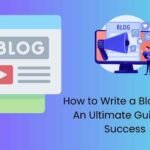In the digital world, blogging has become one of the most powerful tools for sharing knowledge, building authority, and connecting with an audience. Whether you’re a business owner, a thought leader, or someone passionate about a specific topic, a well-written blog can be your gateway to reaching and impacting others. But how exactly do you write a blog that grabs attention and provides value?

Let’s dive into the key steps involved in writing a successful blog post.
1. Choose Your Topic and Know Your Audience
2. Create a Compelling Headline
3. Draft an Engaging Introduction
4. Organize Your Content with Structure and Subheadings
A well-structured blog post is essential for both effective writing and reader engagement. Clear organization not only helps you articulate your thoughts more cohesively but also enhances the overall readability of your content. Here’s how to structure your blog effectively using subheadings and a defined format:
Use a Clear Format
Establish a consistent format for your blog post to guide readers through your content smoothly. A typical structure includes:
- Introduction: This section should include a hook to grab attention and provide an overview of what readers can expect from the post.
- Main Body: Break this down into multiple sections, each with a relevant subheading. Each subheading should cover a specific point or theme that contributes to the overall topic.
- Conclusion: Summarize the key takeaways from your post and include a call-to-action (CTA) to encourage reader engagement, such as asking them to comment, share, or read related content.
Create Subheadings for Clarity
Subheadings act as signposts, helping readers navigate your content. They break up large blocks of text and make your article more scannable. For instance, if you’re writing about “How to Improve SEO,” your subheadings could be structured like this:
- Understanding SEO Basics: Define what SEO is, its importance, and how it affects website visibility.
- On-Page vs. Off-Page SEO: Explain the differences between on-page (elements within your website) and off-page (external factors that influence your ranking) SEO techniques.
- Tools to Boost SEO Efforts: Introduce various tools and software that can assist with keyword research, site audits, and performance tracking.
- Common SEO Mistakes to Avoid: List frequent pitfalls that beginners encounter and provide tips on how to steer clear of them.
Each subheading should guide the reader toward the next logical point, ensuring a coherent flow throughout the post.
Use Bulleted or Numbered Lists
Incorporate bulleted or numbered lists where appropriate to make complex information more digestible. This can help break down steps, tips, or key points clearly. For example:
Tips for Effective On-Page SEO:
- Optimize title tags and meta descriptions.
- Use header tags (H1, H2, H3) for organization.
- Include internal and external links.
- Ensure content is high-quality and relevant.
Keep Paragraphs Short
Even with structured subheadings, it’s important to keep paragraphs concise. Aim for 2-3 sentences per paragraph to enhance readability. Large blocks of text can be overwhelming, making readers less likely to engage with your content.
5. Write in a Conversational Tone
When it comes to blogging, the tone you choose can significantly impact how readers perceive and engage with your content. Unlike academic papers or formal business reports, blog writing thrives on a conversational and engaging tone. Here’s how to achieve that:
Speak Directly to Your Reader
Imagine you’re having a friendly chat with your readers. Use direct address by incorporating words like “you” and “your.” This makes your writing feel more personal and relatable. For example:
- Instead of: “The implications of this strategy can be observed in enhanced customer satisfaction.”
- Try: “You’ll notice that using this strategy can really boost your customers’ satisfaction.”
This approach invites readers into a dialogue, making them feel included and valued.
Use Simple Language
Avoid overly complex vocabulary and jargon that might alienate or confuse your audience. Keep your language straightforward and accessible. For instance:
- Instead of: “The integration of multiple communication channels facilitates enhanced user engagement.”
- Say: “Using different platforms helps you connect better with your audience.”
Simple language not only clarifies your message but also ensures that it resonates with a broader audience, regardless of their familiarity with the topic.
Incorporate Humor and Personal Touch
Don’t hesitate to add a bit of humor or personal anecdotes where appropriate. This can lighten the mood and create a more enjoyable reading experience. For example, if you’re writing about productivity tips, you could share a funny story about a time when you struggled to stay focused:
“Just last week, I found myself in a deep rabbit hole of YouTube videos on cat training instead of tackling my to-do list. If you’ve ever gone down a similar path, you’re not alone!”
Use Short Sentences and Paragraphs
Long, complex sentences can be hard to follow and may cause readers to lose interest. Aim for short, punchy sentences that convey your point quickly. Similarly, keep paragraphs brief—2-3 sentences are ideal. This not only enhances readability but also keeps the pace of your writing engaging.
Ask Questions
Engaging your readers with questions can spark their curiosity and encourage them to think more deeply about the topic. For example:
“Have you ever wondered why some people seem to get so much done while others struggle? Well, I’m here to share some secrets that could change your productivity game!”
Questions invite readers to reflect on their experiences and relate to the content, making your writing feel more interactive.
6. Incorporate Visuals and Media
In the digital landscape, attention spans are short, and visuals play a crucial role in capturing and maintaining your audience’s interest. Incorporating various forms of media into your blog can significantly enhance its appeal and improve overall engagement. Here’s how to effectively use visuals and media in your blog posts:
Use Relevant Images
Images are powerful tools for storytelling. They can evoke emotions, clarify points, and draw readers in. For instance, if you’re discussing the benefits of a healthy diet, including vibrant images of fresh fruits and vegetables can inspire and motivate your readers. Always choose high-quality images that align with your content.
Add Infographics
Infographics are an excellent way to present complex information in a visually appealing manner. They combine graphics with data to help explain concepts quickly and clearly. For example, if you’re writing about the steps in a marketing strategy, an infographic summarizing each step with visuals can make it easier for readers to understand and remember.
Embed Videos
Videos can provide a dynamic way to engage your audience. Whether it’s a tutorial, an interview, or a behind-the-scenes look, videos can enhance your message and cater to different learning styles. For example, if your post is about digital marketing techniques, embedding a short video that demonstrates a particular strategy can add immense value.
Use Screenshots
When explaining processes or step-by-step guides, screenshots can be incredibly helpful. They provide a visual reference, making it easier for readers to follow along. For instance, if you’re writing a tutorial on setting up a website, include screenshots of each step to guide readers through the process more effectively.
Break Up Text with Visuals
Long blocks of text can be daunting, leading to reader fatigue. Incorporating visuals breaks up the text, making your blog more inviting and easier to read. Use images, charts, or quotes to create visual breaks throughout the post. This not only enhances the overall layout but also keeps readers engaged.
Optimize Visuals for the Web
While visuals are essential, it’s crucial to ensure that they are optimized for the web. Large image files can slow down your page load times, leading to a poor user experience. Use tools to compress images without sacrificing quality, and ensure that you’re using the right file formats (like JPEG for photos and PNG for graphics). Additionally, always include alt text for images to improve SEO and make your content more accessible.
Pro Tip
To maximize the impact of your visuals, consider using a mix of different types (images, infographics, videos) to cater to diverse audience preferences. Also, be mindful of your blog’s overall aesthetic; ensure that your visuals align with your brand and the tone of your content.
7. Add Valuable, Actionable Content
When readers visit your blog, they’re often looking for practical, actionable insights that they can implement in their lives or work. To keep your audience engaged and encourage them to return, it’s essential to provide valuable content that goes beyond general advice. Here’s how to ensure your blog posts are filled with actionable takeaways:
Be Specific
Avoid vague suggestions and focus on providing specific, actionable steps. Instead of saying, “Improve your productivity,” offer detailed guidance. For instance:
- Instead of: “Try to stay organized.”
- Try: “Use a digital task manager like Todoist or Trello to keep track of your daily tasks. Set specific deadlines and prioritize tasks using color-coding.”
By offering concrete recommendations, you empower your readers to take immediate action.
Provide Step-by-Step Instructions
When discussing complex processes, break them down into easy-to-follow steps. This not only simplifies the information but also makes it more manageable for readers. For example, if you’re writing about creating a content calendar, outline the steps like this:
- Identify Your Goals: Determine what you want to achieve with your content.
- Choose a Format: Decide whether you’ll use a spreadsheet, a digital tool, or a physical planner.
- Plan Your Topics: Brainstorm content ideas relevant to your audience and your goals.
- Schedule Posting Dates: Assign specific dates to each piece of content, keeping in mind key events or seasons.
By breaking the process into steps, you make it easier for readers to follow along and implement the strategies you recommend.
Include Real-World Examples
Incorporate real-world examples or case studies to illustrate your points. This adds credibility to your advice and shows readers how others have successfully applied similar strategies. For instance, if discussing social media marketing, mention how a specific brand grew its following by engaging with users through consistent content and authentic interaction.
Recommend Tools and Resources
Providing recommendations for tools, resources, or apps can enhance the value of your content. List specific tools that can help readers implement your advice effectively. For example, if you’re discussing email marketing, you might suggest:
- Mailchimp: For creating and managing email campaigns.
- Canva: For designing eye-catching graphics for your emails.
Including links to these tools can also make it easier for readers to access them directly.
Encourage Reflection and Action
At the end of your post, encourage readers to reflect on how they can apply what they’ve learned. A simple prompt like, “What’s one actionable step you’ll take this week to improve your productivity?” invites engagement and reinforces the idea of taking action.
8. Optimize for SEO
Search Engine Optimization (SEO) is essential for increasing the visibility of your blog and attracting more readers. By optimizing your content for search engines, you can improve your rankings and ensure that your blog reaches a wider audience. Here are some key SEO practices to keep in mind when writing your blog posts:
Research and Use Keywords
Keywords are the phrases or terms that users type into search engines when looking for information. Conduct keyword research to identify relevant terms related to your blog topic. Tools like Google Keyword Planner, Ubersuggest, or Ahrefs can help you discover keywords with high search volumes and low competition.
- Placement: Once you’ve identified your target keywords, strategically incorporate them throughout your post, particularly in:
- The headline (title).
- The introduction: Use the main keyword within the first 100 words.
- Subheadings: This helps break up the content and signals to search engines the main topics covered.
- The conclusion: Reinforce the topic and keyword usage.
Write a Compelling Meta Description
The meta description is a brief summary of your blog post that appears in search engine results. While it doesn’t directly affect rankings, a well-crafted meta description can significantly improve your click-through rate. Keep these tips in mind:
- Length: Aim for 150-160 characters to ensure the entire description is visible.
- Clarity: Clearly summarize what the post is about.
- Call-to-Action (CTA): Encourage users to click by including a strong CTA, such as “Discover how to boost your productivity with these proven tips!”
Use Internal and External Links
Linking is crucial for providing additional context and improving SEO:
- Internal Links: These are links to other content within your own website. They help guide readers to related articles and keep them on your site longer, which can reduce bounce rates. For instance, if you mention productivity in your blog, link to a previous post on time management strategies.
- External Links: Link to credible and authoritative sources relevant to your topic. This adds depth to your content and helps establish your credibility. Make sure the external links are to high-quality sites (e.g., government, educational institutions, or reputable organizations) to reinforce your post’s reliability.
Include Alt Text for Images
When you add images to your blog, always include alt text (alternative text). Alt text serves several important purposes:
- SEO Benefits: It helps search engines understand the content of the image, which can improve your ranking in image searches.
- Accessibility: Alt text provides context for visually impaired readers using screen readers, ensuring they understand the content and context of your images.
Make your alt text descriptive yet concise. For example, instead of using “image1.jpg,” use “Infographic showing productivity hacks for remote workers.”
9. Conclude with a Call-to-Action (CTA)
A well-crafted conclusion is essential for wrapping up your blog post effectively. It not only reinforces the key points you’ve discussed but also encourages readers to take further action. A clear and compelling Call-to-Action (CTA) can significantly enhance reader engagement and drive traffic to other parts of your site. Here’s how to create an impactful conclusion with a strong CTA:
Summarize Key Points
Begin your conclusion by briefly summarizing the main takeaways from your post. This helps reinforce what the readers have learned and ensures that the essential information is fresh in their minds. For example:
“By implementing these seven strategies for effective blogging, you can improve your writing, engage your audience, and enhance your online presence.”
Craft a Clear Call-to-Action
After summarizing, invite your readers to take specific actions based on the content of your post. Here are several effective types of CTAs you can use:
- Encourage Comments: Ask readers to share their thoughts, experiences, or questions in the comments section. This fosters community engagement and encourages discussion. For instance:
- “What blogging strategies work best for you? Share your thoughts in the comments below!”
- Suggest Related Blog Posts: Guide readers to additional content on your blog that complements the topic they just read about. This keeps them engaged with your site longer. For example:
- “If you found this post helpful, check out our article on ‘10 Tips for Effective Content Marketing’ for more insights!”
- Invite Subscriptions: Encourage readers to subscribe to your newsletter or follow you on social media for updates on future posts. A simple invitation can be effective:
- “Don’t miss out on our latest tips and resources! Subscribe to our newsletter for regular updates straight to your inbox.”
- Offer Free Resources: If you have a free resource related to the topic, promote it as part of your conclusion. This could be an eBook, checklist, or template that provides additional value:
- “Looking for more in-depth guidance? Download our free eBook, ‘The Ultimate Blogging Guide,’ to kickstart your blogging journey today!”
- Promote Services or Products: If you offer services or products that align with your content, invite readers to learn more:
- “Interested in personalized blogging coaching? Visit our services page to find out how we can help you achieve your blogging goals!”
10. Edit and Proofread Thoroughly
Editing and proofreading are critical steps in the blogging process that can significantly enhance the quality of your post. Taking the time to refine your content ensures clarity, improves readability, and minimizes errors that could distract or confuse your readers. Here’s how to effectively edit and proofread your blog before publishing:
Review for Clarity and Flow
As you read through your post, pay attention to the overall clarity and flow of your writing. Ask yourself:
- Does each paragraph convey a clear idea?
- Is the information logically organized?
- Do the transitions between paragraphs and sections feel smooth?
If something feels unclear or disjointed, consider restructuring your sentences or paragraphs for better coherence.
Check for Grammar and Spelling Errors
Grammar and spelling mistakes can undermine your credibility as a writer. Use tools like Grammarly or Hemingway Editor to catch common errors and improve the overall quality of your writing. These tools can help identify:
- Grammatical issues: Subject-verb agreement, verb tense consistency, punctuation errors, etc.
- Spelling mistakes: Misspelled words can detract from your professionalism.
- Readability: Some tools highlight overly complex sentences or passive voice, allowing you to simplify and strengthen your writing.
Read Aloud
A powerful editing technique is to read your blog post aloud. This practice can help you:
- Identify awkward phrasing: Hearing your words can reveal sentences that sound unnatural or convoluted.
- Catch errors you might miss when reading silently: You may find typos or mistakes that escape your notice during a silent review.
- Assess the overall flow: Reading aloud helps you gauge how well the text flows and whether it sounds engaging.
Take a Break Before Final Edits
After writing, give yourself some time away from the post. A short break can provide you with fresh eyes when you return to edit, making it easier to spot errors and areas for improvement.
Get a Second Opinion
If possible, consider having someone else read your post before publishing. A fresh pair of eyes can catch mistakes you may have overlooked and provide valuable feedback on clarity and engagement.
Conclusion
Writing a successful blog takes planning, creativity, and attention to detail. By choosing the right topic, engaging your audience with a compelling headline and introduction, and delivering valuable content that’s optimized for SEO, you can create a blog post that informs, engages, and converts. Follow these steps consistently, and you’ll be on your way to becoming a confident and effective blogger.
FAQs
1. What is a blog?
A blog is a regularly updated website or web page that is typically run by an individual or a small group. It often presents informal discussions about various topics, allowing readers to engage through comments.
2. Why should I start a blog?
Starting a blog can help you share your expertise, connect with an audience, improve your writing skills, and even generate income through ads, sponsorships, or selling products/services.
3. How do I choose a blogging platform?
Choose a platform based on your needs, technical skills, and goals. Popular platforms include WordPress, Blogger, and Medium. WordPress is highly customizable, while Medium offers a simple, built-in audience.
4. What niche should I blog about?
Select a niche that you are passionate about and knowledgeable in. Consider your interests, experiences, and what your target audience is looking for. A focused niche helps establish authority and attract a dedicated readership.
5. How do I come up with blog post ideas?
You can generate ideas by:
- Researching trending topics in your niche
- Using keyword research tools
- Exploring FAQs in your area of expertise
- Reading other blogs and taking notes on what resonates with you
6. How long should a blog post be?
While there’s no strict rule, blog posts typically range from 1,000 to 2,500 words. Focus on providing value and depth to the topic, regardless of the length. Search engines tend to favor longer, informative content.
7. How often should I publish new blog posts?
Consistency is key. Aim to publish new posts weekly or biweekly, but prioritize quality over quantity. Establish a schedule you can maintain in the long run.
8. What should I include in a blog post?
Include:
- A compelling headline
- An engaging introduction
- Organized content with subheadings
- Valuable and actionable information
- Relevant images or visuals
- A conclusion with a call-to-action
9. How can I promote my blog?
Promote your blog by:
- Sharing posts on social media
- Joining relevant online communities and forums
- Engaging with other bloggers
- Utilizing email marketing
- Implementing SEO strategies to improve search visibility
10. How do I make money from blogging?
You can monetize your blog through:
- Affiliate marketing
- Sponsored posts and collaborations
- Selling digital products or courses
- Displaying ads (like Google AdSense)
- Offering services related to your niche
11. What is SEO, and why is it important for blogging?
Search Engine Optimization (SEO) is the practice of optimizing your blog to improve its visibility on search engines. Good SEO practices help attract organic traffic, increasing your blog’s reach and audience.
12. How do I optimize my blog for SEO?
Optimize your blog by:
- Conducting keyword research
- Using keywords strategically in titles, headings, and throughout the content
- Creating quality backlinks
- Optimizing images with alt text
- Ensuring your blog is mobile-friendly and loads quickly
13. Can I guest post on other blogs?
Yes! Guest posting can help you reach new audiences, build backlinks, and establish authority in your niche. Look for blogs that accept guest contributions and align with your topic.
14. What tools do I need to start a blog?
Essential tools include:
- A blogging platform (like WordPress)
- Domain name and hosting service
- Graphic design software (like Canva) for images
- SEO tools (like Yoast SEO or SEMrush)
- Analytics tools (like Google Analytics) to track performance
15. How do I track my blog’s performance?
Use tools like Google Analytics to monitor traffic, user behavior, and engagement metrics. This data helps you understand your audience and improve your content strategy.
16. What should I do if I run out of blog post ideas?
If you’re stuck, try:
- Re-visiting old posts and updating them
- Exploring your blog’s comments for questions or topics
- Conducting polls or surveys to gather topics from your audience
17. How do I create a strong brand for my blog?
Develop a unique brand identity by:
- Choosing a memorable blog name and domain
- Designing a cohesive logo and visual style
- Establishing a consistent tone and voice in your writing
- Engaging with your audience to build community
18. Is it necessary to have a professional-looking blog?
While it’s not strictly necessary, having a polished and professional design can enhance credibility and improve user experience. A well-designed blog encourages visitors to stay longer and engage more.
19. How do I handle negative comments or criticism?
Address negative comments calmly and professionally. Consider the feedback constructively and respond thoughtfully. If comments are abusive or spammy, you can choose to delete or block them.
20. What are some common blogging mistakes to avoid?
Common mistakes include:
- Inconsistent posting schedules
- Ignoring SEO practices
- Neglecting audience engagement
- Writing without a clear purpose or focus
- Failing to promote your content






